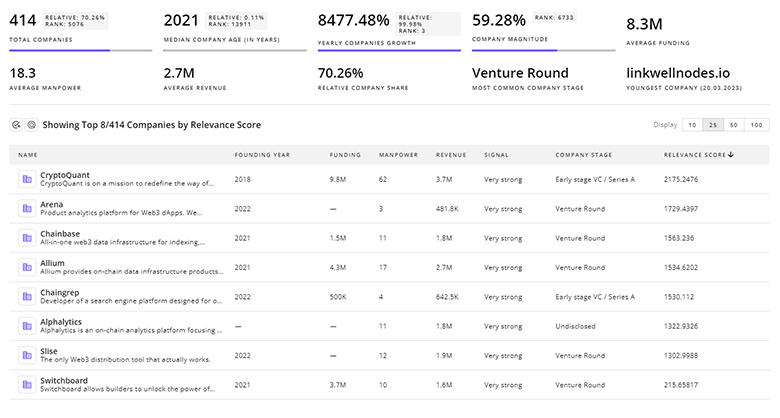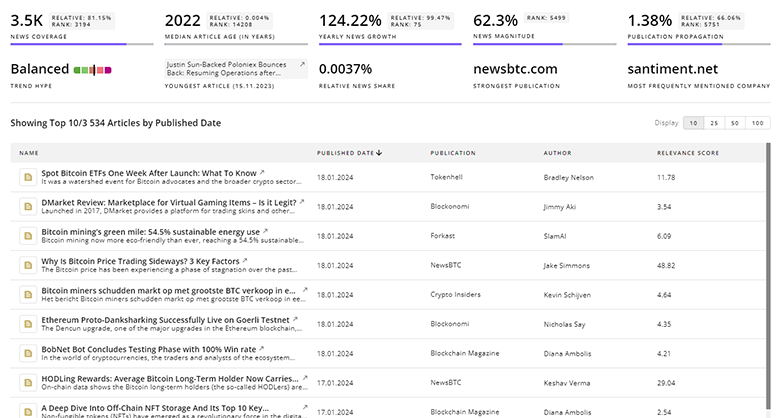
Autonomous AI Report
: Analysis on the Market, Trends, and TechnologiesThe autonomous AI market is accelerating quickly: the internal trend data records a 2023 market base of USD 4.8 billion and a projected value of USD 28.5 billion by 2028 at a 43.0% CAGR, signalling intense near-term commercial uptake and investment flows. External forecasts reinforce a multi-year expansion (for example, Market.us projects USD 170.6 billion by 2034 and GM Insights reports a 30.3% CAGR from 2025–2034), which together describe a market that is moving from pilot projects to broad enterprise deployments across automotive, logistics, healthcare, and cybersecurity market_us – 2025 gminsights – 2024.
This report was last updated 56 days ago. Spot an error or missing detail? Help us fix it by getting in touch!
Topic Dominance Index of Autonomous AI
To identify the Dominance Index of Autonomous AI in the Trend and Technology ecosystem, we look at 3 different time series: the timeline of published articles, founded companies, and global search.
Key Activities and Applications
- Autonomous driving and ADAS: production and R&D activity concentrates on perception, planning, and explainable decision logic for Level 4/5 vehicles, with strong industry adoption in automotive and transport verticals marketresearchfuture - 2025.
- Industrial robotics and intralogistics: AI agents run material handling, inventory robots, and inspection robots to reduce labor cost and increase 24/7 throughput in warehouses and plants.
- Autonomous cybersecurity (continuous threat hunting): autonomous agents perform continuous attack simulation, vulnerability validation, and guided remediation to shorten detection-to-remediation time and reduce manual SOC workloads
- Autonomous knowledge and customer agents: enterprise agents execute multi-step business processes (sales triage, customer service, recruitment workflows) without constant human supervision, raising productivity and reducing cycle times alliedmarketresearch - 2025.
- Edge-deployed operational autonomy: on-device agents for real-time control (manufacturing controllers, drones, AVs) reduce latency, preserve privacy, and allow continued operation when networks degrade
Emergent Trends and Core Insights
- Platform consolidation and vendor stratification: markets show a drift to integrated solutions (agent platforms + orchestration + safety tooling), creating a winner-take-most dynamic for platform providers and a squeeze on pure point solutions
- Software captures the lion's share of value: platform and software components dominate spend versus hardware, driving recurring revenue models such as subscription and outcome pricing
- Longer-horizon agent competence: new hybrid LLM and reasoning models enable agents to maintain memory, plan across thousands of steps, and act autonomously for extended periods, expanding viable use cases from short tasks to sustained operations technologyreview - 2025.
- Human oversight calibrated by autonomy level: firms adopt "autonomy sliders" that prescribe when humans act as delegators versus interveners, which reduces deployment risk while improving throughput
- Regulatory and assurance frameworks rise in importance: demand grows for explainability, risk-assessment, and red-teaming services to meet regulation and enterprise risk policies thebusinessresearchcompany - 2025.
Technologies and Methodologies
- Reinforcement learning and continuous policy optimization: used for adaptive control in vehicles, robotics, and resource allocation where sequential decisions matter
- Large language model hybrids plus persistent memory: LLM hybrids that hold long memory files let agents plan and act over multi-hour tasks with reduced reward-hacking behavior
- Computer vision fused with sensor suites: camera, LiDAR, and radar fusion remains central to perception stacks for vehicles and inspection robots, with SLAM and digital twins used for validation
- Edge inference and on-device runtimes: lightweight runtimes and model compression let agents run close to data sources for latency and privacy benefits
- Neurosymbolic and explainable models: combinations of symbolic rules and neural nets provide audit trails and support certification in safety-critical domains
Autonomous AI Funding
A total of 488 Autonomous AI companies have received funding.
Overall, Autonomous AI companies have raised $12.9B.
Companies within the Autonomous AI domain have secured capital from 1.6K funding rounds.
The chart shows the funding trendline of Autonomous AI companies over the last 5 years
Autonomous AI Companies
- Autonomos.AI — Provides continuous autonomous threat hunting and penetration simulation that discovers, validates, and guides remediation without manual SOC gating. The platform reduces dwell time and produces prioritized, proof-backed remediation steps designed for enterprise and public sector compliance regimes. Its autonomous security focus maps directly to the autonomous cybersecurity activity in the market
- Yugaa — Builds autonomous AI agents for customer engagement and process automation that operate 24/7 across chat and voice channels. Yugaa targets end-to-end task ownership (lead qualification, scheduling, basic resolution) so clients can shift routine workflows from humans to agents while retaining escalation hooks. The product caters to mid-market digital contact centers that need rapid automation rollouts
- Kurious Learning Labs — An education-focused company that applies autonomous learning concepts to AI training kits and curricula, supporting workforce development for AI and robotics roles. By embedding hands-on autonomous system exercises, Kurious seeks to address the talent gap that limits enterprise adoption. The company operates multiple innovation labs and training programs in India
- MOTOR Ai — A German firm developing cognitive, explainable autonomy tailored to EU safety and legal requirements for urban driving at Level 4/5. MOTOR Ai emphasizes decision explainability and formal safety properties so their stack can map to certification processes rather than relying solely on massive scenario training. That positioning appeals to OEMs facing strict EU compliance needs
Identify and analyze 1.7K innovators and key players in Autonomous AI more easily with this feature.

1.7K Autonomous AI Companies
Discover Autonomous AI Companies, their Funding, Manpower, Revenues, Stages, and much more
Autonomous AI Investors
TrendFeedr’s investors tool offers a detailed view of investment activities that align with specific trends and technologies. This tool features comprehensive data on 2.5K Autonomous AI investors, funding rounds, and investment trends, providing an overview of market dynamics.

2.5K Autonomous AI Investors
Discover Autonomous AI Investors, Funding Rounds, Invested Amounts, and Funding Growth
Autonomous AI News
Stay informed and ahead of the curve with TrendFeedr’s News feature, which provides access to 2.2K Autonomous AI articles. The tool is tailored for professionals seeking to understand the historical trajectory and current momentum of changing market trends.

2.2K Autonomous AI News Articles
Discover Latest Autonomous AI Articles, News Magnitude, Publication Propagation, Yearly Growth, and Strongest Publications
Executive Summary
Enterprises face a clear strategic choice: adopt integrated agent platforms that deliver measurable, recurring automation value or risk trailing behind as the market consolidates. Short term, prioritize use cases where autonomy replaces repetitive, high-volume human tasks and where edge deployment reduces latency or preserves sensitive data. Invest in explainability, safety testing, and human-in-the-loop controls to accelerate procurement approvals and regulatory acceptance. Build internal skills in sequential decision methods, long-horizon LLM management, and on-device inference to capture value from the next wave of autonomous AI deployments.
Interested in enhancing our coverage of trends and tech? We value insights from experts like you - reach out!













